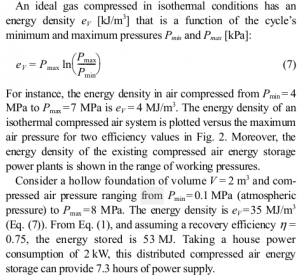Compressed Air Calculations: Difference between revisions
Jump to navigation
Jump to search
No edit summary |
No edit summary |
||
| Line 4: | Line 4: | ||
*Need to use PV-Work Calculator -https://www.geogebra.org/m/KAZHEN8c | *Need to use PV-Work Calculator -https://www.geogebra.org/m/KAZHEN8c | ||
*See formula for energy density - [https://www.researchgate.net/figure/Energy-Density-of-Compressed-Air-in-Isothermal-Conditions-The-energy-density-is-a_fig1_225467912]. This shows 50MJ/m3 = 0.05 MJ/l at 50% efficiency | *See formula for energy density - [https://www.researchgate.net/figure/Energy-Density-of-Compressed-Air-in-Isothermal-Conditions-The-energy-density-is-a_fig1_225467912]. This shows 50MJ/m3 = 0.05 MJ/l at 50% efficiency | ||
*From | *From [https://www.researchgate.net/publication/225467912_Energy_Geo-Storage_-_Analysis_and_Geomechanical_Implications] | ||
[[File:caespower.png| | [[File:caespower.png|300px]] | ||
=Links= | =Links= | ||
*[[Energy Density of Batteries]] | *[[Energy Density of Batteries]] | ||
[[Category:Calculators]] | [[Category:Calculators]] | ||
Revision as of 14:53, 28 February 2021
- For example, compressed air at 2,900 psi (~197 atm) has an energy density of 0.1 MJ/L calculated from P*deltaV. [1]
- Pressure - N/m2 - 3000 psi = 2E7 Pa. Delta V - of 1 liter or E-3 cu meter - to 214E-3 cu meter.
- PdeltaV=2E7*214E-3=214E4=2E6 = 4MJ for that one expanded liter, as max possible work - but this is just PdeltaV without considering real thermodynamics underneath. Ballpart ok.
- Need to use PV-Work Calculator -https://www.geogebra.org/m/KAZHEN8c
- See formula for energy density - [2]. This shows 50MJ/m3 = 0.05 MJ/l at 50% efficiency
- From [3]
